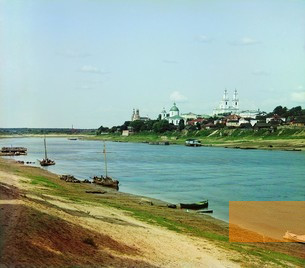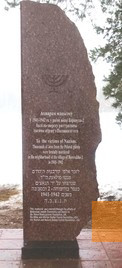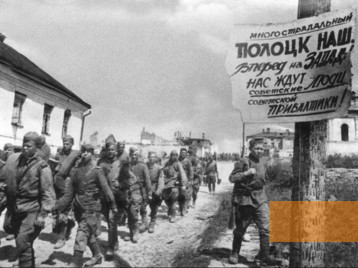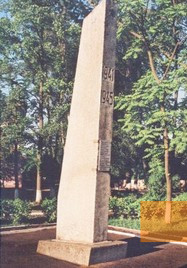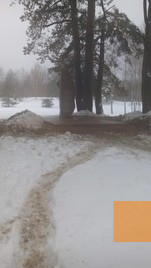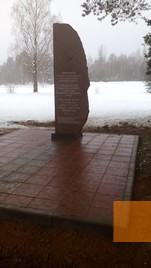In the small Belarusian town of Polotsk (in Belarusian: Polatsk), various memorials commemorate the approximately 8,000 Jews who were murdered there in 1941/1942 by the Germans and their accomplices.
Polotsk, founded around 780 and located about 200 northeast of Minsk on the river Dvina, is considered to be the oldest city in Belarus. Jews settled here with interruptions from the middle of the 16th century. In 1939 about 6,470 Jews lived in the city, corresponding to approximately 30 percent of the total population.
The German Wehrmacht occupied the city on July 16, 1941 and a few days later the Germans shot some 200 members of the local elite, including many Jews. The remaining Jews were forced into forced labour and had to wear badges identifying them as Jews. At the beginning of August all Jews in the city had to move into ghettos. A few weeks later, members of Einsatzkommando 9 (subgroup of Einsatzgruppe) of Einsatzgruppe B (mobile killing unit) carried out the first mass shooting of Jews in Polotsk. The number of victims is unknown. In mid-September 1941, all Jews had to move to a new ghetto which was set up in a former brick factory on the outskirts of the city. Many Jews died of thirst because no water was distributed with the already insufficient food rations.
On November 21, 1941, German soldiers, supported by Belarusian policemen, drove the majority of the ghetto inhabitants into the vicinity of the military settlement Borovukha 2. There they were shot and killed by men of Einsatzkommando 9. In December, the command murdered other Jews in and around Polotsk. Some 615 Jewish skilled workers and their families were initially excluded from the executions until they were also murdered on February 3, 1942.
The German Wehrmacht occupied the city on July 16, 1941 and a few days later the Germans shot some 200 members of the local elite, including many Jews. The remaining Jews were forced into forced labour and had to wear badges identifying them as Jews. At the beginning of August all Jews in the city had to move into ghettos. A few weeks later, members of Einsatzkommando 9 (subgroup of Einsatzgruppe) of Einsatzgruppe B (mobile killing unit) carried out the first mass shooting of Jews in Polotsk. The number of victims is unknown. In mid-September 1941, all Jews had to move to a new ghetto which was set up in a former brick factory on the outskirts of the city. Many Jews died of thirst because no water was distributed with the already insufficient food rations.
On November 21, 1941, German soldiers, supported by Belarusian policemen, drove the majority of the ghetto inhabitants into the vicinity of the military settlement Borovukha 2. There they were shot and killed by men of Einsatzkommando 9. In December, the command murdered other Jews in and around Polotsk. Some 615 Jewish skilled workers and their families were initially excluded from the executions until they were also murdered on February 3, 1942.
In total, German units, above all Einsatzkommando 9 of Einsatzgruppe B, murdered approximately 8,000 Jews from Polotsk and surroundings.
The Red Army liberated Polotsk on July 4, 1944. Only few Jews survived the war. The director of a children's home, who saved several Jews during the war, was honoured in Israel in 1986 as a »Righteous Among the Nations«.
After the war some 3,000 Jews initially returned to Polotsk. Most had survived because they had been able to escape to the interior of the Soviet Union before the arrival of German troops. However, in the 1950s and 1960s many of them moved away from the provincial town of Polotsk, so that in the 1970s only roughly 550 Jews were still counted in the city.
In 1965 a first monument was inaugurated in honour of the »Victims of Fascism«. The Jewish origin of thousands of murdered in Polotsk was not mentioned. In November 2016, the Union of Belarusian Jewish Communities, supported by foundations from the USA and Great Britain, erected a memorial in the Borovukha 2 district, located near the site of the largest mass shooting of November 1941. The inscription in Belarusian, English and Hebrew reads: »To the Victims of Nazism. Thousands of Jews from the Polotsk ghetto were brutally murdered near the village of Borovukha 2 in 1941-1942«. At the top of the monument is the Jewish sympbol Hanukkah.
Today Polotsk once again has an active Jewish community.
After the war some 3,000 Jews initially returned to Polotsk. Most had survived because they had been able to escape to the interior of the Soviet Union before the arrival of German troops. However, in the 1950s and 1960s many of them moved away from the provincial town of Polotsk, so that in the 1970s only roughly 550 Jews were still counted in the city.
In 1965 a first monument was inaugurated in honour of the »Victims of Fascism«. The Jewish origin of thousands of murdered in Polotsk was not mentioned. In November 2016, the Union of Belarusian Jewish Communities, supported by foundations from the USA and Great Britain, erected a memorial in the Borovukha 2 district, located near the site of the largest mass shooting of November 1941. The inscription in Belarusian, English and Hebrew reads: »To the Victims of Nazism. Thousands of Jews from the Polotsk ghetto were brutally murdered near the village of Borovukha 2 in 1941-1942«. At the top of the monument is the Jewish sympbol Hanukkah.
Today Polotsk once again has an active Jewish community.
- Name
- Pamjat zabitych ewrejew Polozku
- Address
-
Vul. Barawaja
211400 Polotsk - Web
- http://www.belarusmemorials.com
- 6663000@gmail.com
- Open
- The memorials are accessible at all times.


